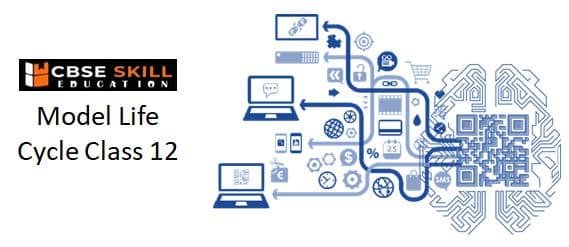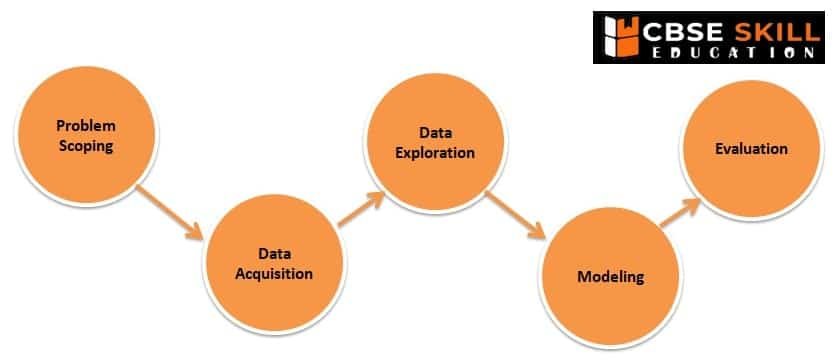Teachers and Examiners (CBSESkillEduction) collaborated to create the Model Life Cycle Class 12. All the important Information are taken from the NCERT Textbook Artificial Intelligence (417).
Model Life Cycle Class 12

AI Model Life Cycle
Students need to understand the AI project cycle in order to have a solid foundation in AI. Students must adopt a thorough strategy to cover every stage of the AI or machine learning life cycle in order to implement successful AI projects. This strategy should start with project scoping and data preparation and progress through all stages of model building, deployment, management, analytics, and full-blown Enterprise AI.
In general, the project scoping, design or construction phase, and deployment in production are the three key phases of every AI project lifecycle. Let’s go over each one, along with the crucial processes and things to bear in mind when putting it into practise.
Model Life Cycle Class 12
Stage of AI Project Cycle

Step 1: Scoping (Requirements analysis)
The project’s goals and objectives are described in the scope statement, which serves as a definition of the project. A description of the constraints, assumptions, deliverables, acceptance criteria, and the scope of the product or solution should be included, according the PMBOK standard.
The planning and motivational parts of your project come first during this stage. If you want your artificial intelligence project to be successful, you must get off to a strong start. Garbage in, garbage out is a terrific saying that sums up this project stage. Accordingly, if the data you gather is poor, you won’t be able to create a powerful AI system, and your entire project will fail.
Model Life Cycle Class 12
Step 2: Design/Building the Model
The next part of the machine learning lifecycle is the design or build phase, which can take a few days to several months, depending on the nature of the project, after the pertinent tasks have been chosen and adequately scoped. In essence, the Design phase is an iterative process that includes all the steps necessary to build an AI or machine learning model, including data acquisition, exploration, preparation, cleaning, feature engineering, testing, and running a number of models to look for patterns in the data or predict behaviours.
During this phase, you need to evaluate the various AI development platforms, e.g.:
a. Open languages — Python is the most popular, with R and Scala also in the mix.
b. Open frameworks — Scikit-learn, XGBoost, TensorFlow, etc.
c. Approaches and techniques — Classic ML techniques from regression all the way to state-of-theart GANs and RL
d. Productivity-enhancing capabilities — Visual modelling, AutoAI to help with feature engineering, algorithm selection and hyperparameter optimization
e. Development tools — DataRobot, H2O, Watson Studio, Azure ML Studio, Sagemaker, Anaconda, etc.
To aid the development teams, various AI development platforms include substantial documentation.
You need to go to the relevant webpages for this documentation, which are as follows, depending on the AI platform you choose:
a. Microsoft Azure AI Platform;
b. Google Cloud AI Platform;
c. IBM Watson Developer platform;
d. BigML;
e. Infosys Nia resources.
Model Life Cycle Class 12
Step 3: Testing
While the fundamental testing concepts are fully applicable in AI development projects, there are additional considerations too. These are as follows:
a. The volume of test data can be large, which presents complexities.
b. Human biases in selecting test data can adversely impact the testing phase, therefore, data validation is important.
c. Your testing team should test the AI and ML algorithms keeping model validation, successful learnability, and algorithm effectiveness in mind.
d. Regulatory compliance testing and security testing are important since the system might deal with sensitive data, moreover, the large volume of data makes performance testing crucial.
e. You are implementing an AI solution that will need to use data from your other systems, therefore, systems integration testing assumes importance.
f. Test data should include all relevant subsets of training data, i.e., the data you will use for training the AI system.
g. Your team must create test suites that help you validate your ML models.
Model Life Cycle Class 12
Employability Skills Class 12 Notes
- Unit 1 : Communication Skills – IV
- Unit 2 : Self-Management Skills – IV
- Unit 3 : Information and Communication Technology Skills – IV
- Unit 4 : Entrepreneurial Skills – IV
- Unit 5 : Green Skills – IV
Employability Skills Class 12 MCQ
- Unit 1 : Communication Skills – IV
- Unit 2 : Self-Management Skills – IV
- Unit 3 : Information and Communication Technology Skills – IV
- Unit 4 : Entrepreneurial Skills – IV
- Unit 5 : Green Skills – IV
Employability Skills Class 12 Questions and Answers
- Unit 1 : Communication Skills – IV
- Unit 2 : Self-Management Skills – IV
- Unit 3 : Information and Communication Technology Skills – IV
- Unit 4 : Entrepreneurial Skills – IV
- Unit 5 : Green Skills – IV
Model Life Cycle Class 12
Artificial Intelligence Class 12 Notes
- Unit 1: Capstone Project
- Unit 2: Model Lifecycle
- Unit 3: Storytelling Through Data
